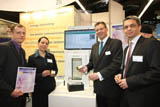embedded world 2013: special award for maintenancefree, self-powered wireless multi-hop sensor network
On February 26, 2013, the Fraunhofer Institute for Integrated Circuits IIS was honored with the embedded world 2013 special award. The combination of two application-oriented technologies allowed the development of a unique, stateof-the-art innovation: a maintenance-free, self-powered wireless multi-hop sensor network. One of the underlying technologies is the s-net® wireless protocol stack, which requires only a tiny amount of energy to initialize and operate a wireless multihop sensor network. The innovation however also relies on highly-efficient Fraunhofer IIS power management circuits for harvesting energy, thus eliminating batteries and thereby the need to charge and replace them. Together, these two developments enable the implementation of large-scale, distributed and maintenance-free sensor networks, paving the way for costeffective Internet of Things applications.

Large-scale capturing, transmitting and processing data becomes an increasingly important aspect for the Internet of Things. For this purpose, multi-hop sensor networks are especially well-suited: By connecting thousands of miniaturized sensor nodes, these networks enable an extremely energy-efficient, scalable and robust data transmission. The sensor nodes allow various objects to interact with their surroundings and the Internet. Minimizing the maintenance and installation effort requires not only the wireless transmission of data, but also a cable- and maintenance-free power concept. This is achieved through energy harvesting technologies that supply the sensor nodes with electrical power by exploiting available ambient sources of energy such as temperature differences or vibrations.
Autonome, eingebettete Systeme für das Internet der Dinge
The Fraunhofer IIS s-net® technology facilitates high-quality data transmission with minimal energy consumptions. The self-organizing network topology can be installed, expanded or scaled-down as required without any configuration effort. In particular, the network recovers automatically from node failures, and the sensor nodes can be installed without any manual planning efforts.
With up to 80 percent efficiency (as opposed to the 30 percent of commercially available components), the thermal generator voltage transformers that were also developed by Fraunhofer IIS achieve maximum power output at a very small temperature difference of only 1 Kelvin. This in turn allows the utilization of smaller and especially low-cost energy transformers.
The combination of these two technologies permits the establishment of large-scale, self-organizing networks where, in contrast to other wireless networks, the routers that forward data are also powered via energy harvesting.
Practical application at the embedded world
Maintenance-free, self-powered wireless multi-hop sensor networks can be deployed wherever the application requires the acquisition and bidirectional transmission of data with a minimal effort for installation, maintenance, or operation. Potential applications include monitoring the structural health of buildings, machines and plants, the automation of complex buildings, and various applications in the fields smart metering and security..
At the embedded world 2013 fair, Fraunhofer IIS demonstrated a wireless window monitoring system, jointly developed with Seuffer GmbH & Co. KG, that transmits the window status (open, closed, propped open) via s-net® sensor network powered by energy harvesting techniques.